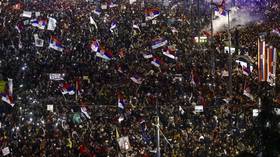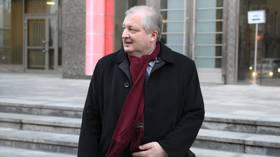Why Israel strikes Syria

Israeli airstrikes reportedly targeted southern Damascus on Wednesday, causing material damage and reflecting a larger trend of what Syria considers “Israeli aggression” against it. But what does Israel seek to achieve with these strikes?
At around 11:35pm (local time) Israel launched surface-to-surface missiles “from the direction of the occupied Syrian Golan, targeting some points in the vicinity of Zakiya town,” according to Syrian state media. Syrian opposition media then claimed that a Syrian military base used by pro-Iran militias was struck.
It was the third Israeli strike within the past month, with the previous attack occurring just last week. On January 31, Israeli airstrikes near Damascus reportedly targeted weapons belonging to Lebanese Hezbollah.
Wednesday’s airstrikes came shortly after a speech delivered earlier that day by the Secretary General of Hezbollah, Sayyed Hassan Nasrallah in which he addressed the Israeli attacks. He claimed that his group possesses the ability “to transform our thousands of rockets into precision-guided missiles” with the cooperation of “experts from the Islamic Republic of Iran.” During his televised address, Nasrallah also said that Hezbollah has been developing precision missiles and “drones in Lebanon for a long time,” jokingly adding “whoever wants to buy them, submit an order.”
Nasrallah also threatened Israel with “another Ansariya,” which is the name for a 1997 operation in which Hezbollah ambushed and killed 12 Israeli soldiers attempting to plant explosives in Lebanon. After referring to a number of known engagements between Hezbollah and Israel, labeled by Nasrallah as “the battles in between wars,” he remarked that “when it comes to the actual implementation of operations, they need to bring in commandos, generals, soldiers, elite groups…they bring them from the sea,” he stated, warning Israel that “we are ready for them.”
According to an alleged insider source found through journalist Laith Marouf, Nasrallah’s speech referred to a thwarted Israeli special forces operation, describing it but refraining from announcing it. The “resistance source” did not wish to be named for security reasons, claiming that on February 2, two Israeli special forces teams had allegedly landed in the areas of Zouk Mosbeh (18km North of Beirut), and Jounieh (22km North of Beirut) attempting to reach beachfront safehouses. This information could not be independently verified.
“They [the Israeli forces] had activated their local network of agents…they had two operations running simultaneously, because the Israeli modus operandi is that they have one operation to distract from the other, which would go after the target. Alternatively the second team could complete the operation if the other fails,” the source claimed.
“The communications opened up between the teams and their agents, revealing the agents and so they were captured [by Hezbollah], these were not those in the safe houses but those who were on the ground preparing for the action against the targets,” the source claimed. I asked whether any of those captured were Israeli nationals and the reply was that only Lebanese agents were arrested. According to the source, Hezbollah had discovered only one of the teams, faced with the choice of engaging would mean killing or capturing them, but without the second team located this would have been costly. What then allegedly occurred, was that Hezbollah forces allowed for the Israelis to withdraw to sea, after the teams’ cover was blown, in order to avert the possibility of war between the two sides. “They [the Israelis] thought that they had located a manufacturing site for either missiles or drones,” according to Laith Marouf, who alleged that this was the target of the Israeli special forces teams.
Beyond the tensions between Lebanese Hezbollah and Israel is also the Israeli fixation on cementing its presence in the Golan Heights, internationally recognised as an occupied territory belonging to Syria.
Israeli Prime Minister Naftali Bennett, speaking at the ‘Makor Rishon Golan Conference’ on October 11, said that his government intended to quadruple the Israeli settler population in the area. In December, Israel approved a $317 million plan to double the settler population. Since October, it has launched over 10 known attacks on Syria, allegedly assassinated an ex-member of the Syrian parliament, and bombarded the civilian port of Latakia twice, directly targeting Syria’s air defense systems, weapons storage facilities, and killing soldiers in the process.
Although the war in Syria has come to a somewhat temporary halt, giving time for the Syrian government to attempt to normalize ties throughout the region and reintegrate itself into the Arab League, Israel is making it clear that, without concessions, little will return to normal.
In June 2015, it spoke of creating a “safe zone”, or buffer-zone, between it and the rest of Syria in order to protect the Druze community that primarily live near or in the Syrian province of Sweida. Israel even began forming strong relations with Druze opposition groups in southern Syria to achieve this aim. According to an investigation by The Intercept, in early 2018 Israel was at stage two of implementing a buffer zone – which was to be set up in southern Syria – with the intention of solidifying its hold on the Golan Heights. However, this plan was ruined when Syrian opposition groups and ISIS militants were defeated and the Syrian government retook the south in an offensive in July 2018.
Rare anti-Syrian government demonstrations erupted last week in Sweida province over collapsing living conditions and corruption. Preceding these was the inauguration of the Syrian al-Liwa Party, a sectarian Druze party attached to the military enitity known as the Counter-Terrorism Force.
Speaking to al-Monitor, Nowras Aziz, an independent journalist from Sweida now living in France, said that “Abo Kheer [Syrian al-Liwa Party leader] had contacted the [US-led international] coalition forces at Al-Tanf base in the second half of 2020, explaining his plan in Suwayda [province]. Abu Kheer had informed the forces that the steps would include declaring full control over the eastern villages [of Suwayda] and removing any presence of the Syrian regime or Iran in that area.” This information, if true, indicates the threat the group poses to the Syrian government and how it aligns with the goals of Israel. There is no proof that Israel is involved with the Syrian al-Liwa Party but, given its connection to the US, it’s likely that the two groups’ alignment on strategy is not simply chance.
Israel similarly seeks to weaken Damascus and disrupt the movement of Iran-aligned armed groups inside Syrian territory and this includes attempting to eliminate the weapons of any such groups. Although Hezbollah claims it is not affected by Israeli airstrikes, the Syrian government is most certainly being made to pay a price by Tel Aviv, both for threatening its presence in the Golan Heights and for facilitating the presence of Hezbollah and Iran – real strategic threats to Israel – in the country. Although the Syrian war has quieted down, Israel is not letting go of its goal to force concessions on Syrian President Bashar Assad and its attempt to send a message to Hezbollah and Tehran.
The statements, views and opinions expressed in this column are solely those of the author and do not necessarily represent those of RT.

















